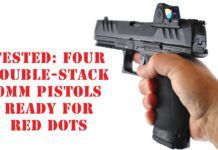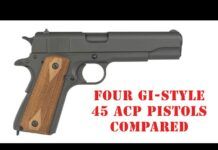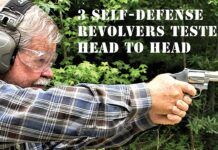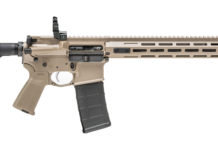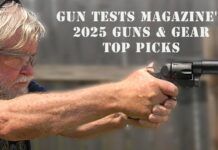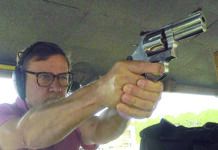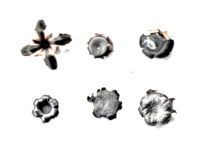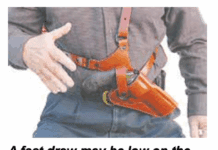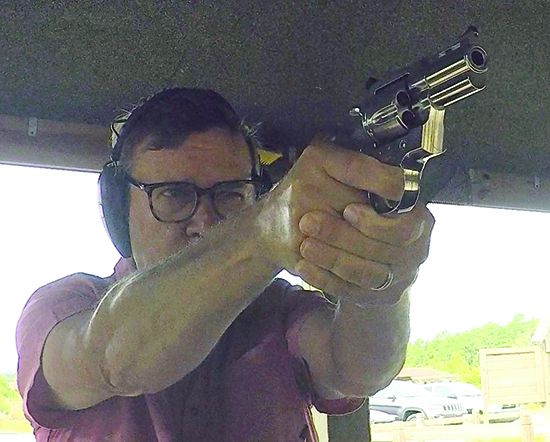When the FBI carried 357 Magnum revolvers between 1981 and 1991, the standard issue was a S&W Model 13 with a medium-sized round-grip K-frame and a 3-inch barrel. Consider the Model 13 a benchmark for a concealed-carry 357 Magnum revolver. It offers better shootability than a smaller-frame revolver with a smaller grip, yet doesn’t feel like a brick on your hip when you carry it.
Medium-frame revolvers are exactly what they sound like. They are an in-between frame that is larger and heavier than a small-frame revolver, yet smaller and less weighty than a large-frame revolver. The extra weight makes medium-frame revolvers easier to shoot well and offers better help with recoil management, while still allowing the revolver to be concealed more easily. You could argue that medium-frame revolvers are just right for concealed carry, offering the hand-filling performance of a large-frame revolver yet sitting in a holster lightly enough to carry all day.
In this vein, we opted to review three medium-frame 357 Magnum revolvers and chose the following: a Colt Python Classic PYTHON-SP2WCTS 357 Magnum, $1317; a Henry Firearms Big Boy Revolver H017BDM, $722; and a Smith & Wesson Model 686 Plus 164300, $896.
We also wanted to see what velocity/energy we would gain or lose with revolvers equipped with a 4-inch, 3-inch, and 2.5-inch barrel. A 3-inch barrel is the benchmark for optimal performance in a medium-size 357 Magnum, according to the FBI.
Even though the three revolvers were new, we checked the cylinder-to-frame headspace and barrel-and-chamber alignment. As suspected, both were in spec. The cylinder-gap spec can indicate whether a revolver will spit out debris that can be felt on your hands. The normal cylinder-gap range is 0.004-0.007 of an inch, measured with a feeler gauge. The Henry had a gap of 0.55 inch, the Colt measured 0.004 inch, and the S&W was a very tight 0.002 inch. We assumed we would not have any problems with splash with these revolvers, and we didn’t. We did note that the S&W may need to be maintained more often if the shooter uses only lead bullets, which may build up deposits on the cylinder face and gum up the works due to the 0.002-inch gap. Here is what we found after the shooting was done.
Colt Python Classic PYTHON-SP2WCTS 357 Magnum
$1317
Gun Tests grade: A-
The Python Classic had retro-cool good looks, but the grip is dated and not as comfortable to shoot with hot 357 Magnum ammo. The double-action trigger pull is very smooth, and the single-action trigger pull is fairly crisp. Accuracy was good, and the large sights were easy to see.
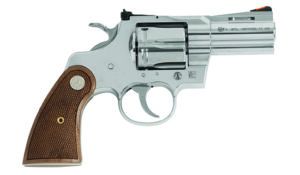
| Action Type | DA/SA |
|---|---|
| Overall Length | 8.0 in. |
| Barrel Length | 2.5 in. |
| Barrel Rifling Twist Rate | 1:14 in. |
| Sight Radius | 4.2 in. |
| Overall Height | 5.1 in. |
| Maximum Width | 1.5 in. |
| Weight Unloaded | 36.5 oz. |
| Weight Loaded | 39.3 oz. |
| Cylinder Gap | 0.004 in. |
| Capacity | 6 |
| Frame | Polished stainless steel |
| Barrel | Polished stainless steel |
| Cylinder | Polished stainless steel |
| Frame Front Strap Height | 2.5 in. |
| Frame Back Strap Height | 3.8 in. |
| Grip | Checkered wood |
| Grip Thickness (Maximum) | 1.3 in. |
| Grip Circumference (Maximum) | 5.5 in. |
| Front Sight | Red ramp, screwed |
| Rear Sight | Adjustable notch |
| Trigger Pull Weight (Double Action) | 10.0 lbs. |
| Trigger Pull Weight (Single Action) | 5.9 lbs. |
| Trigger Span (Double Action) | 3.6 in. |
| Trigger Span (Single Action) | 3.0 in. |
| Safety | Transfer bar |
| Warranty | Limited 1 year |
| Telephone | (800) 962-2658 |
| Website | Colt.com |
| Made In | U.S. |
Colt has been consistently producing new Python variants since the pistol was re-introduced in 2020. In 2023, Colt offered a snubnose variant called the Python Classic with a 2.5-inch barrel. The Python Classic has retro-cool looks with a bright stainless-steel finish, traditional checkered wood grips straight out of the 1950s, and the iconic underlug vent-rib barrel. Like all new Pythons, the Classic is chambered in 357 Magnum and has a clockwise-rotating cylinder that holds six rounds.
In hand, the Classic has heft, and while the Altamont-produced wood grips look retro cool, the grip design is dated. There is a reason shooters installed Tyler T-grips on Smiths and Colts back in the day.
Unloaded, the Classic weighs a stout 36.5 ounces, the heaviest of the revolvers tested. That weight, however, is an asset when firing 357 Magnum ammo. The Classic was the smallest revolver in overall length due to the stubby barrel.
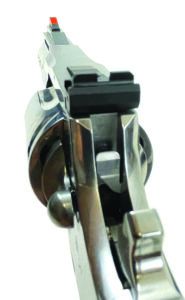
Sights consist of a red-insert ramp front that is serrated to nullify sun glare and an adjustable rear sight. The notch in the rear sight is plenty wide for fast alignment. We did wish the shooter-facing side of the rear sight was serrated to deal with sun glare better.
Crane-to-frame fit was tight with hardly any cylinder wiggle. The shooter pulls the cylinder latch backward on the Colt to swing out the cylinder and load and unload. The double-action trigger pull is very smooth, weighing in at 10 pounds; the single-action trigger pull is a fairly heavy 5.6 pounds. The Classic uses a U-shaped main spring that allows the shooter to stage the trigger by pressing it backward until the cylinder rotates and a chamber aligns with the barrel. Completing the trigger stroke fires the revolver. This is helpful when trying to make a more accurate shot in the A-zone. The trigger is serrated so your finger stays put during trigger stroke. The hammer spur is large and textured for no-slip cocking.
Accuracy was good, and the large sights helped us wring out good groups. The best group was with Federal Hydra-Shok 158-grain JHPs, which measured 1.92 inches; average was 1.95 inches. That was impressive with a 2.5-inch-barrel snubnose revolver. Accuracy eroded with the 125-grain BJHP Winchester PDX1 load, which measured 2.2 inches and averaged 2.9 inches. The Magtech 158-grain LRN 38 Special’s best was 2.6 inches and it averaged 3.1. The Classic had the second-best accuracy behind the S&W. The 2.5-inch barrel did not give up a lot of muzzle velocity/energy.
The small grip creates a void between the rear of the trigger guard and the front grip strap. When shooting mild 38 Special ammo, the Classic was comfortable to shoot. With hot 357 Magnum ammo, recoil jammed our knuckles at times. For speed shooting, we fired at 7 yards in double action using IDPA-style targets. Using a high grasp on the Classic for double-action speed shooting at 7 yards, with 38 Special the gun was easy to control and fun to shoot. The weight and smooth trigger allowed us to keep hits in the center-of-mass A-zone.
Our Team Said: The Python Classic is a gorgeous retro-looking revolver that responds like a dated revolver. It could pull duty as a concealed-carry gun, but you may want to replace the grips. We think it is an excellent choice as a BBQ revolver.
| 38 SPECIAL AND 357 MAGNUM RANGE DATA | |||
|---|---|---|---|
| 38 Special Magtech 158-grain LRN 38A | Colt Python Classic | Henry Big Boy Revolver | S&W Model 686 Plus |
| Average Velocity | 772 fps | 785 fps | 780 fps |
| Muzzle Energy | 209 ft.-lbs. | 216 ft.-lbs. | 214 ft.-lbs. |
| Smallest Group | 2.67 in. | 2.57 in. | 1.83 in. |
| Average Group | 3.15 in. | 2.64 in. | 2.57 in. |
| 357 Magnum Winchester PDX1 125-grain BJHP | Colt Python Classic | Henry Big Boy Revolver | S&W Model 686 Plus |
| Average Velocity | 1129 fps | 1128 fps | 1126 fps |
| Muzzle Energy | 506 ft.-lbs. | 353 ft.-lbs. | 352 ft.-lbs. |
| Smallest Group | 2.26 in. | 2.79 in. | 2.49 in. |
| Average Group | 2.94 in. | 3.19 in. | 3.05 in. |
| 357 Magnum Federal Hydra-Shok 158-grain JHP P357HS1 | Colt Python Classic | Henry Big Boy Revolver | S&W Model 686 Plus |
| Average Velocity | 1200 fps | 1203 fps | 1214 fps |
| Muzzle Energy | 506 ft.-lbs. | 509 ft.-lbs. | 517 ft.-lbs. |
| Smallest Group | 1.92 in. | 2.94 in. | 1.51 in. |
| Average Group | 1.95 in. | 3.13 in. | 2.03 in. |
To collect accuracy data, we fired five-shot groups from a bench using a rest. Distance: 25 yards with open sights, firing single action. Velocities and energies were recorded using a Garmin Zero C1 Pro chronograph. LRN = lead round nose. BJHP = Bonded Jacketed Hollow Point. JHP = jacketed hollow point.
Written and photographed by Robert Sadowski, using evaluations from Gun Tests Team members. GT



